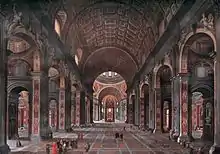George Cooke (painter)
George Esten Cooke (1793–1849) was an itinerant United States painter who specialized in portrait and landscape paintings and was one of the South's best known painters of the mid nineteenth century.[1] His primary patron was the industrialist Daniel Pratt, who built a gallery in Prattville, Alabama solely to house Cooke's paintings.[1]
George Cooke | |
|---|---|
| Born | George Esten Cooke 1793 |
| Died | 1849 (aged 55–56) |
| Nationality | American |
| Known for | Primarily portrait painting |
| Patron(s) | Daniel Pratt |
Early career and fame
Born in St. Mary's County, Maryland,[2] Cooke abandoned a fledgling career in business at an early age in order to become a full-time artist. After several years of painting portraits for a living, Cooke left for what would become a five-year tour of Europe. His time there was mostly spent learning from and copying the works of the Renaissance master artists, with many of Cooke's copies being sent back to the United States for show or sale.[3]
At some time between 1826 and 1830, he made a copy in Paris of The Raft of the Medusa, a monumental painting by Théodore Géricault depicting a notorious incident following a shipwreck. Cooke's smaller version (4' x 6') was shown in Boston, Philadelphia, New York and Washington, D.C, to crowds, who knew about the controversy surrounding subject. Reviews favoured the painting, which also stimulated plays, poems, performances and a children's book. It was bought by a former admiral, Uriah Phillips, who left it in 1862 to the New York Historical Society, where it was miscatalogued as by Gilbert Stuart and remained inaccessible, until the mistake was uncovered in 2006, after an enquiry by Nina Athanassoglou-Kallmyer, professor of art history at the University of Delaware. The university's conservation department undertook restoration of the work.[4]
After returning to the U.S., Cooke and his wife spent the next decade traveling and working with no fixed home. His work took him throughout the Southern United States, where he primarily made his living painting portraits of both famous and ordinary people, and, by the 1840s, his portraits had earned him both financial success and regional fame.[1]
Daniel Pratt's patronage

In 1844 in New Orleans, Cooke started what would become his most important professional relationship when he met Alabama industrialist Daniel Pratt. Pratt was immediately drawn to Cooke's work, and decided to give the artist two floors in one of his warehouses for Cooke to use as a gallery and studio.[3] After a few years, Pratt decided to take the unusual step of adding a separate gallery to his home in Prattville, Alabama, solely to house Cooke's art. Pratt also commissioned Cooke to paint what would become his best known work, the Interior of St. Peter's Rome, a giant painting based on a smaller piece that Cooke had previously painted during his travels in Europe.[3] In 1867, Pratt donated Interior of St. Peter's Rome to the University of Georgia, where it still hangs today in the University's chapel. At 17 by 23.5 feet, the work was said to be the largest framed oil painting in the world at the time of its donation,[5] and it still ranks among the world's largest.[3]
Death and the dispersal of his work
The health of George Cooke had never been very good, and in 1849, in New Orleans, Orleans Parish, Louisiana, he contracted cholera and died quickly from the illness.
Nearly twenty years after his death, the gallery in Pratville was found to be infested with dry rot and had to be torn down to prevent the rot from spreading. As a result, all of Cooke's work housed at the gallery wound up being destroyed or dispersed. It was this threat that prompted Daniel Pratt to donate Interior of St. Peter's Rome to the University of Georgia.[3]
Notes and references
| Wikimedia Commons has media related to: |
- "George Cooke (1793-1849)". Georgia Humanities Council. Retrieved February 6, 2008.
- Estill Curtis Pennington (2012). Romantic Spirits: Nineteenth Century Paintings of the South from the Johnson Collection. Cane Ridge Publishing House. ISBN 978-0-615-56265-0.
- O'Donnell, Kevin E. (2004). "The Artist in the Garden: George Cooke (1793-1849) and the Ideology of Fine Arts Painting in Antebellum Georgia". Crossroads: A Southern Culture Annual: 73–97.
- Moncure, Sue. "The case of the missing masterpiece", University of Delaware, November 14, 2006. Retrieved on January 6, 2008.
- "Painting and Restoration". University of Georgia. Archived from the original on June 1, 2008. Retrieved February 6, 2008.